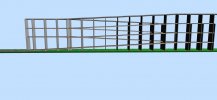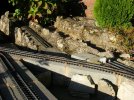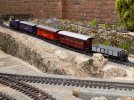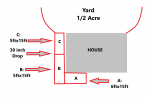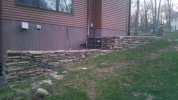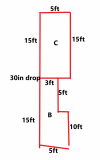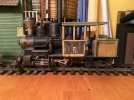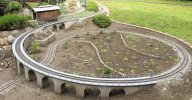in real life they build switchbacks on mountains, to gain height, while saving length.
i tried to achieve that too.
but IMHO that is difficult or impossible to achieve in Largescale/G-Scale.
(for reasons of avaiable space we already "compress" the lengths of our lines too much.)
i'll explain, using my personal experience and logic:
my actual layout is the third, where i pushed grades as steep, as possible.
without using cogs, i reached 6% grades on straights. (that is 1 in 16.7 for the imperial educated) (or +- 20mm per 1'/300mm section)
but:
- it needs strong, short, heavy locos, best only with two axles and additional weight. (i destroyed a Bachmann 4-6-0, trying to draw just itself and her tender up the 6%) (i ended up with 2 1/2 pound total weight per driven axle)
- one loco = one Buhler motor draws up only three 1 foot/30cm coaches or cars. so, using LGB Stainzes plus LGB power tenders, i have trains of five cars being comfortably drawn up that grade. that is a train of 6 1/2 foot(195cm) length. (7 standard rail sections needed.)
- each grade needs gradual easing in and out at both ends. 0-4-0 locos and short roling stock can be acomodated with two half sections of 4% and 2% resp. at each end. (longer 4wheel cars (16"/410mm) need half a section more. - eightwheeled cars and longer locos need at least 4 half sections)
- curves add to the drag. LGB R1 curves at 4% grade drag as much as straights at 6%.
these facts here above are the result of decades of trial & error "investigation"
----------------------
let us say, there is 10 metres space. (near 32foot)
coming in from the left with a R1 curve 75cm - easing up 30cm - grade 6% 625cm - easing down 30cm - turnout 30cm - "switching-tail" 210cm. that gives us 625cm (plus 30 for the easings at half value) at 6% = 39cm height won.
we switch back from right to left from the mentioned "switching tail", turnout and easing. together 270cm - up the grade 460cm - easing, switch and left "switching-tail" 270cm. that gives us 460 + 30cm at 6% = 29cm height won.
leaving the left "switching-tail" to the upper curve on the right gives us another 39cm.
so, with one switching back and forth the absolute max heightwin for short trains as descripted above would be about 107cm(3.4foot) on a 1o metre (31.7foot) stretch. (at about 50cm (20") wide - if not allowing for landscape) ... or, said otherwise: one in ten. not bad.
but, don't forget:
you want more cars, you need less grade and longer "switching-tails".
you want longer locos, you need longer easings and (much) lesser grades.
--------------------------
in my case, i didn't do it. reasons:
on the space avaiable, i now have one upgrade, one downgrade and one flat line.
for the planned automatic traffic in two directions using simple DC, the switchbacks would have been a nightmare.


